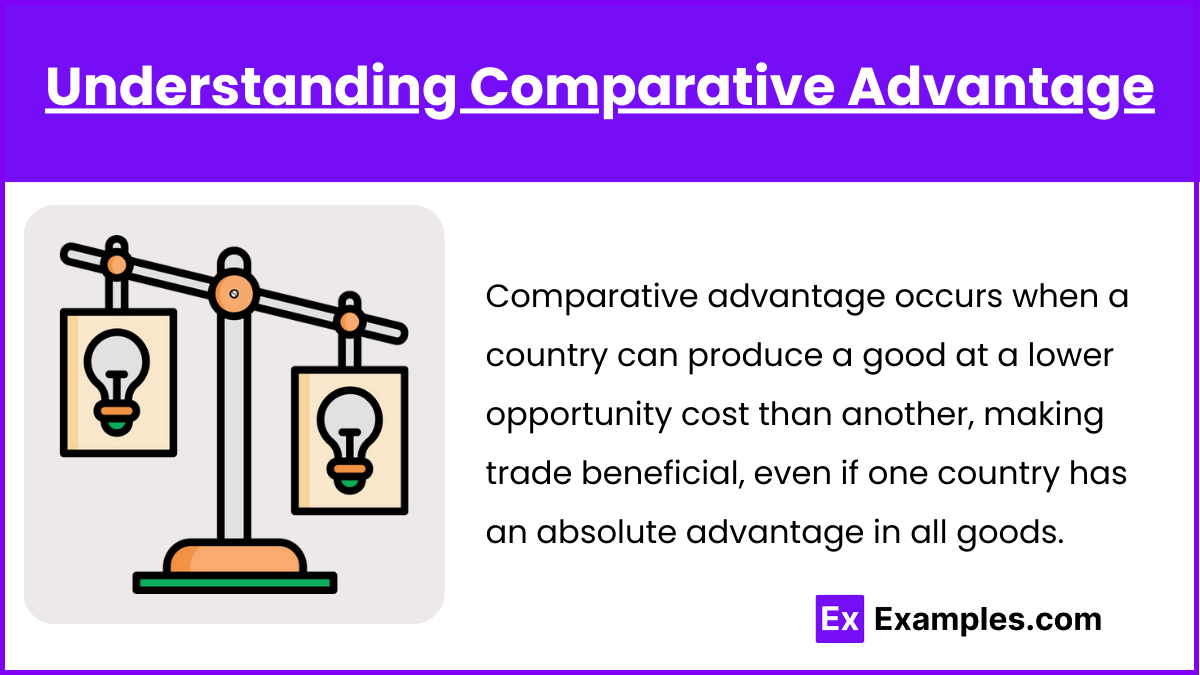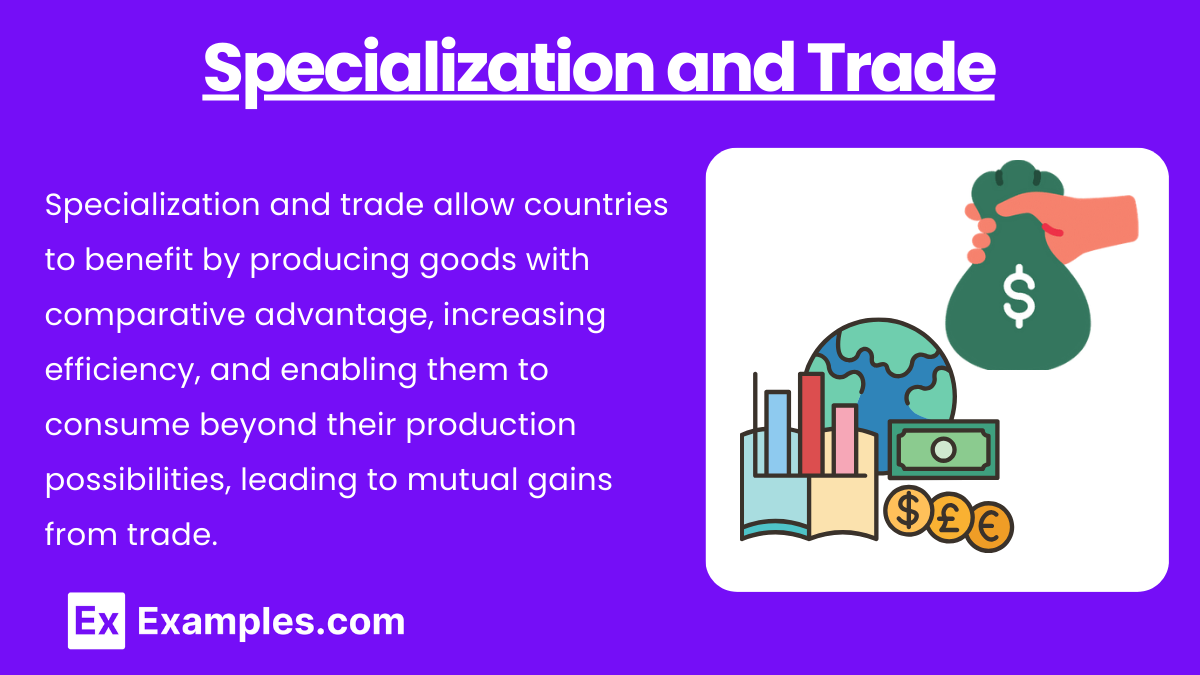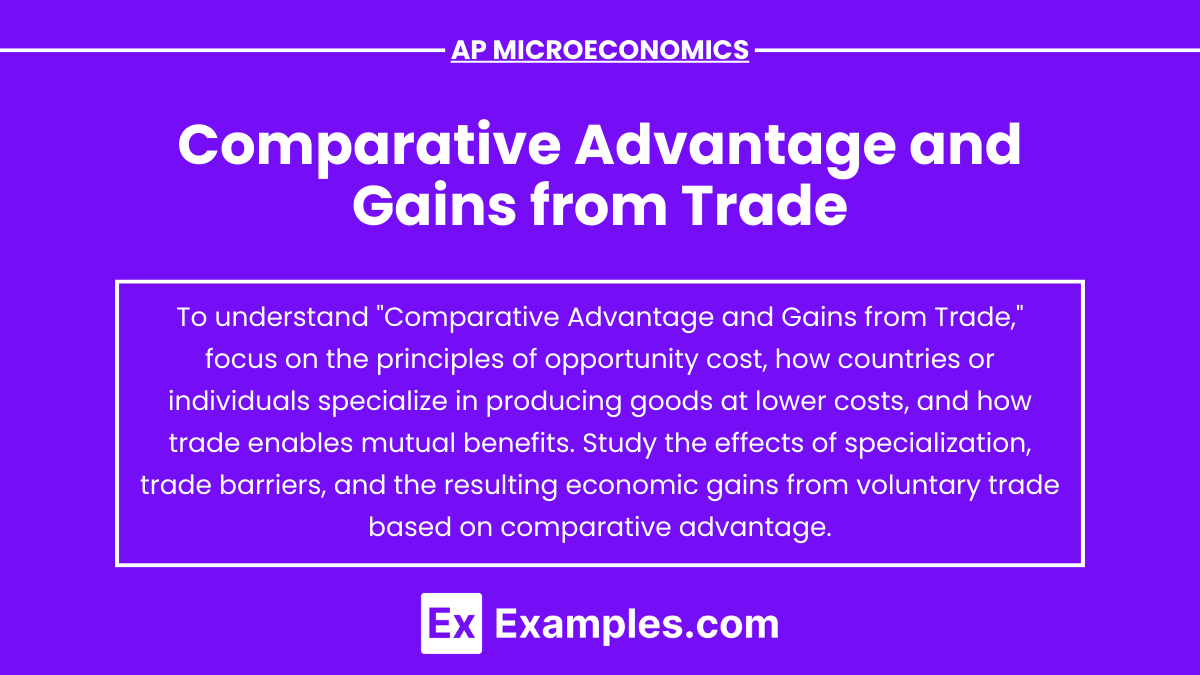Comparative advantage is a fundamental concept in AP Microeconomics that explains how individuals, firms, or countries can benefit from trade by specializing in the production of goods where they have a lower opportunity cost. This specialization allows them to produce more efficiently, leading to gains from trade when they exchange goods and services with others. By focusing on what they do best and trading for what they need, both parties can consume beyond their own production possibilities, increasing overall economic welfare and efficiency.
Learning Objectives
In the topic of “Comparative Advantage and Gains from Trade” for AP Microeconomics, you should learn how to identify comparative advantage by calculating opportunity costs, understand the difference between comparative and absolute advantage, and explain how specialization and trade lead to mutually beneficial outcomes. Additionally, you should focus on applying these concepts to real-world examples and trade scenarios, analyzing the effects of trade on resource allocation, and understanding how trade expands a country’s consumption possibilities beyond its production capacity.
Comparative Advantage and Gains from Trade in AP Macroeconomics
Comparative Advantage refers to the ability of a country or individual to produce a good or service at a lower opportunity cost than another. It is one of the key principles in international trade, explaining why countries specialize in the production of certain goods even when they can produce a variety of goods themselves.
Understanding Comparative Advantage

- Opportunity Cost is central to comparative advantage. It measures what must be given up to produce one more unit of a particular good.
- A country can have a comparative advantage in the production of a good if it has to forgo less of other goods compared to another country.
- This is distinct from absolute advantage, where a country or individual can produce more of a good with the same resources. Even if a country has an absolute advantage in producing everything, trade can still be beneficial through comparative advantage.
Specialization and Trade

- Specialization and trade allow countries to benefit by producing goods with comparative advantage, increasing efficiency, and enabling them to consume beyond their production possibilities, leading to mutual gains from trade.
- When countries specialize in producing goods in which they have a comparative advantage, and then trade with other nations, they can mutually benefit.
- Trade allows countries to consume beyond their production possibilities, achieving gains from trade.
- Gains from trade arise because specialization according to comparative advantage allows for more efficient allocation of resources and increased total output.
Example:
- Consider two countries: Country A and Country B.
- Country A can produce either 10 units of cloth or 5 units of wine.
- Country B can produce either 8 units of cloth or 16 units of wine.
- To calculate comparative advantage:
- In Country A, the opportunity cost of producing 1 unit of cloth is 0.5 units of wine.
- In Country B, the opportunity cost of producing 1 unit of cloth is 2 units of wine.
- Since Country A has a lower opportunity cost for producing cloth, it has a comparative advantage in cloth production.
- Conversely, Country B has a lower opportunity cost in producing wine and thus has a comparative advantage in wine production.
By specializing in their respective comparative advantages (cloth for Country A and wine for Country B), both countries can trade and be better off, consuming more of both goods than they would in isolation.
Implications for Microeconomics

- Trade Agreements and Globalization: Comparative advantage encourages firms and industries to enter into competitive global markets by reducing trade barriers through agreements, promoting efficient exchanges of goods and services at the micro level.
- Resource Allocation: Comparative advantage leads firms to specialize in areas where they are most productive, enabling more efficient use of resources, lower production costs, and better allocation, often resulting in reduced prices and higher consumer satisfaction.
- Income Distribution and Job Displacement: While specialization increases overall efficiency, firms in less competitive sectors may experience job losses or wage reductions, affecting income distribution and local employment.
Examples
Example 1. Country Specialization in Agricultural vs. Industrial Goods
Consider two countries: Country X is highly efficient in growing crops due to favorable climate, while Country Y has an advanced industrial base capable of producing machinery at a low cost. Even though Country X could produce machinery, it has a higher opportunity cost in doing so compared to producing crops. Country Y, although capable of growing crops, can produce more machinery with the same resources. By specializing in agriculture, Country X trades crops for machinery from Country Y, both countries benefit from increased output and better resource allocation.
Example 2. Individual Skill Sets in a Market Economy
In a market economy, individuals can also exhibit comparative advantage. For example, a lawyer and a secretary both perform tasks like organizing documents and drafting legal briefs. The lawyer, however, has a comparative advantage in legal work due to extensive training, while the secretary excels at organizational tasks. If both specialize according to their strengths, the lawyer focuses on legal briefs, and the secretary handles administrative work, they can increase productivity and gain more from their cooperation than if each attempted to do both tasks themselves.
Example 3. Regional Production of Coffee and Electronics
Imagine two regions: Region A is known for its coffee production due to optimal growing conditions, and Region B is an electronics hub due to technological expertise. If Region A tried to produce electronics, it would have a high opportunity cost, just as Region B would face inefficiencies in growing coffee. By trading coffee for electronics, both regions maximize their output and enjoy greater consumption, illustrating the gains from trade due to comparative advantage.
Example 4. Comparative Advantage Between Small and Large Businesses
In an economy, a small bakery specializes in artisan bread production, while a large industrial bakery produces mass quantities of packaged bread. The small bakery has a comparative advantage in producing high-quality, unique loaves, while the large bakery has a comparative advantage in economies of scale for producing large volumes. If the small bakery focuses on premium, high-margin products and trades with the large bakery for other types of goods, both businesses benefit through specialization and efficient resource allocation.
Example 5. Natural Resource Trade: Oil vs. Manufactured Goods
Consider Country A, which has vast oil reserves, and Country B, which specializes in manufacturing electronics. Country A has a comparative advantage in oil production, as its opportunity cost for extracting oil is much lower compared to developing a manufacturing base. Conversely, Country B has a comparative advantage in electronics due to its advanced infrastructure. By trading oil for electronics, Country A can focus on resource extraction while Country B focuses on manufacturing, leading to a more efficient global allocation of resources and gains for both countries.
Multiple Choice Questions
Question 1
Two countries, Country X and Country Y, are both capable of producing wheat and cars. Country X can produce either 20 tons of wheat or 5 cars in a given time period, while Country Y can produce either 10 tons of wheat or 10 cars. Which of the following statements is correct?
A) Country X has a comparative advantage in producing cars.
B) Country Y has a comparative advantage in producing wheat.
C) Country X has a comparative advantage in producing wheat.
D) Neither country has a comparative advantage in producing either good.
Answer: C) Country X has a comparative advantage in producing wheat.
Explanation: To determine comparative advantage, we need to look at the opportunity cost for each country in producing wheat and cars:
- In Country X, the opportunity cost of producing 1 ton of wheat is 0.25 cars (5 cars / 20 tons of wheat).
- In Country Y, the opportunity cost of producing 1 ton of wheat is 1 car (10 cars / 10 tons of wheat).
Since Country X gives up fewer cars to produce wheat (0.25 cars vs. 1 car), it has a comparative advantage in producing wheat. Country Y, on the other hand, has a lower opportunity cost in producing cars (1 car vs. 0.25 cars per ton of wheat), meaning Country Y has a comparative advantage in producing cars.
Question 2
Which of the following statements best describes how countries can benefit from trade based on comparative advantage?
A) Countries should produce goods in which they have an absolute advantage and trade those goods.
B) Countries should produce goods in which they have a comparative advantage and trade for other goods.
C) Countries should avoid trade because it leads to unequal wealth distribution.
D) Countries should only trade with others that have lower production costs in all goods.
Answer: B) Countries should produce goods in which they have a comparative advantage and trade for other goods.
Explanation: The theory of comparative advantage states that even if a country does not have an absolute advantage in producing any good, it can still benefit from trade by specializing in the good for which it has a comparative advantage (lower opportunity cost). This allows both trading partners to benefit by consuming more than they would be able to produce on their own.
Option A refers to absolute advantage, which is not the main criterion for determining trade benefits. Option C is incorrect because trade typically leads to mutual benefits. Option D is incorrect because countries do not need to have lower production costs in all goods to benefit from trade.
Question 3
Suppose Country A can produce either 50 units of corn or 100 units of steel, and Country B can produce either 40 units of corn or 80 units of steel. What should these countries do to maximize the gains from trade?
A) Country A should specialize in steel, and Country B should specialize in corn.
B) Country A should specialize in corn, and Country B should specialize in steel.
C) Both countries should produce equal amounts of corn and steel.
D) Both countries should avoid trade since they produce similar goods.
Answer: A) Country A should specialize in steel, and Country B should specialize in corn.
Explanation: First, calculate the opportunity cost for each country:
- For Country A:
- The opportunity cost of producing 1 unit of corn is 2 units of steel (100 steel / 50 corn).
- The opportunity cost of producing 1 unit of steel is 0.5 units of corn (50 corn / 100 steel).
- For Country B:
- The opportunity cost of producing 1 unit of corn is 2 units of steel (80 steel / 40 corn).
- The opportunity cost of producing 1 unit of steel is 0.5 units of corn (40 corn / 80 steel).
Both countries have the same opportunity cost for steel and corn. However, gains from trade can still occur if Country A specializes in producing steel (which it produces in greater quantity), and Country B specializes in producing corn. This way, both countries can maximize their production and trade for the other good.
Option B is incorrect because both countries have the same opportunity cost, but specialization based on quantity leads to greater trade efficiency. Option C and D are incorrect as they don’t maximize gains from trade.


